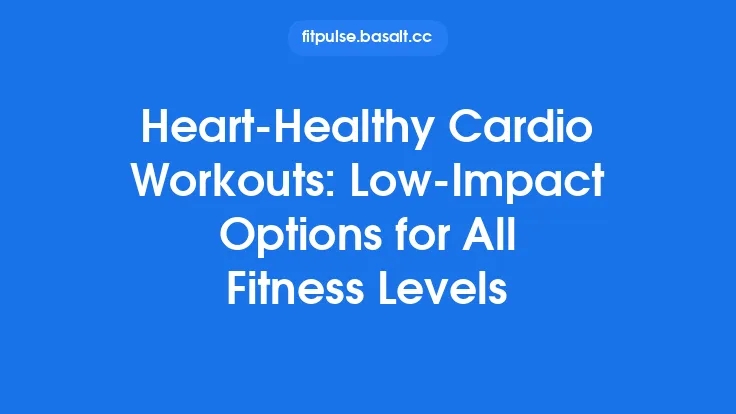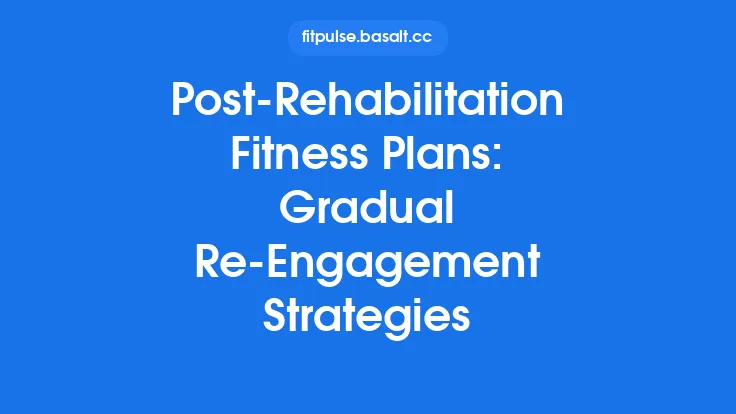Living with a chronic heart condition can feel like navigating a constantly shifting landscape. While the diagnosis often brings concerns about safety, fatigue, and the fear of overexertion, regular cardiovascular activity remains one of the most powerful tools for improving heart health, functional capacity, and overall quality of life. The key lies in tailoring exercise strategies that respect the unique physiological constraints of each condition, while still providing enough stimulus to promote meaningful adaptations. This article walks you through the science‑backed foundations, practical programming steps, and everyday considerations that empower individuals with chronic heart conditions to move confidently toward better cardiovascular fitness.
Understanding Chronic Heart Conditions
A “chronic heart condition” is an umbrella term that includes several diagnoses, each with distinct pathophysiology:
| Condition | Primary Pathophysiology | Typical Symptoms | Exercise Considerations |
|---|---|---|---|
| Coronary Artery Disease (CAD) | Atherosclerotic plaque narrowing coronary arteries → reduced myocardial oxygen delivery | Angina, dyspnea on exertion | Avoid high‑intensity bursts that provoke ischemia; focus on steady‑state aerobic work. |
| Heart Failure (HF) – Reduced EF | Impaired systolic function → lower stroke volume, elevated filling pressures | Fatigue, peripheral edema, shortness of breath | Begin with low‑intensity, short bouts; monitor for excessive fatigue or fluid retention. |
| Heart Failure – Preserved EF | Diastolic dysfunction → stiff ventricles, limited filling | Exercise intolerance, pulmonary congestion | Emphasize gradual volume loading and controlled heart rate. |
| Arrhythmias (e.g., Atrial Fibrillation) | Irregular electrical activity → variable ventricular response | Palpitations, dizziness | Maintain heart rate within a safe range; consider rate‑control medications. |
| Valvular Disease (e.g., Aortic Stenosis) | Obstructed outflow or regurgitant flow → altered hemodynamics | Syncope, exertional dyspnea | Avoid high afterload activities; prioritize moderate intensity. |
| Post‑Myocardial Infarction (Post‑MI) | Necrotic myocardial tissue → scar formation, reduced contractility | Chest discomfort, limited tolerance | Structured cardiac rehabilitation phases guide safe progression. |
Understanding the underlying mechanism helps clinicians and exercisers decide which variables—intensity, duration, mode, and frequency—need the most careful adjustment.
Core Principles of Cardiovascular Training for the Heart
- Specificity – The cardiovascular system adapts to the type of stress placed upon it. Aerobic activities (walking, cycling, swimming) improve stroke volume, capillary density, and mitochondrial efficiency, directly benefiting cardiac output.
- Progressive Overload – Incremental increases in workload (time, speed, or resistance) stimulate adaptation without overwhelming the compromised myocardium. The “10% rule” (no more than a 10% increase in weekly volume) is a practical guideline.
- Individualization – Baseline functional capacity, medication regimen (e.g., beta‑blockers, ACE inhibitors), and comorbidities dictate the starting point and progression speed.
- Recovery – Adequate rest between sessions allows the heart to remodel positively. For many with chronic conditions, 48–72 hours of low‑intensity activity or complete rest is optimal after a higher‑intensity day.
- Monitoring – Real‑time feedback (heart rate, perceived exertion, symptom check) is essential to stay within safe physiological limits.
Initial Assessment and Baseline Testing
Before prescribing any program, a thorough assessment establishes safety thresholds and informs goal setting.
| Assessment | What It Reveals | Typical Tools |
|---|---|---|
| Medical Clearance | Confirmation of diagnosis, medication effects, contraindications | Physician’s clearance, recent cardiac imaging |
| Resting & Exercise Heart Rate | Baseline autonomic tone, beta‑blocker impact | Pulse oximeter, ECG |
| Blood Pressure Response | Hemodynamic stability during activity | Automated cuff, ambulatory monitor |
| Functional Capacity Test | VO₂max estimate, endurance level | 6‑Minute Walk Test (6MWT), submaximal treadmill protocol (e.g., Bruce Stage 1) |
| Symptom Provocation | Threshold for angina, dyspnea, arrhythmia | Graded exercise test with continuous ECG monitoring |
| Perceived Exertion Scale | Subjective effort rating, useful for day‑to‑day adjustments | Borg RPE 6–20 or 0–10 scale |
Data from these assessments guide the selection of target heart rate zones, session length, and progression cadence.
Designing a Safe Aerobic Program
1. Choose the Right Modality
- Walking – Most accessible, low joint stress, easy to monitor intensity.
- Stationary Cycling – Provides smooth, controlled resistance; ideal for those with balance concerns.
- Elliptical or Recumbent Bike – Offers full‑body movement while limiting impact.
- Aquatic Walking (if medically cleared) – Reduces preload and afterload, but ensure the environment meets safety standards.
2. Establish Target Heart Rate (THR) Zones
Because many patients are on beta‑blockers, the classic “220‑age” formula may overestimate capacity. Two reliable alternatives:
- Karvonen Method (Heart Rate Reserve)
THR = [(HRmax – HRrest) × %Intensity] + HRrest
HRmax can be derived from a submaximal test rather than age‑predicted.
- RPE‑Based Zones
- Light: RPE 2–3 (≈40–50% HRR)
- Moderate: RPE 4–5 (≈50–70% HRR)
- Vigorous: RPE 6–7 (≈70–85% HRR) – generally reserved for stable CAD with physician approval.
3. Session Structure
| Phase | Duration | Focus |
|---|---|---|
| Warm‑up | 5–10 min | Low‑intensity activity, gradual HR rise, dynamic stretching |
| Main Set | 20–30 min (initially) | Sustained aerobic work within target zone |
| Cool‑down | 5–10 min | Gradual HR decline, static stretching, breathing exercises |
For beginners, split the main set into 2–3 intervals (e.g., 5 min on, 2 min off) and progressively merge them.
4. Frequency
- Standard Recommendation: 3–5 days per week of aerobic activity.
- Heart Failure Specific: Start with 3 days, adding a fourth as tolerance improves.
Progression Strategies
- Time‑Based Progression – Add 2–5 minutes to the main set every 1–2 weeks, respecting the 10% rule.
- Intensity‑Based Progression – Once the duration is stable, increase the target zone by 5% of HRR or raise RPE by one point.
- Mode Variation – Alternate walking with cycling to reduce monotony and challenge different muscle groups while keeping overall cardiovascular load constant.
- Interval Introduction – After 6–8 weeks of steady‑state work, incorporate short (30‑60 s) bouts at the upper end of the moderate zone, followed by equal recovery. This can improve VO₂max without excessive overall stress.
- Resistance Integration – Adding 1–2 days of low‑to‑moderate resistance training (e.g., 2 sets of 10–15 reps at 40–60% 1RM) supports muscular endurance and aids venous return, indirectly benefiting cardiac function.
Ongoing Monitoring and Safety Checks
| Parameter | How to Monitor | Action Threshold |
|---|---|---|
| Heart Rate | Chest strap, wrist monitor, or manual pulse | Exceeds upper THR by >10 bpm → reduce intensity or stop |
| Blood Pressure | Automated cuff before, during (if feasible), after | Systolic >180 mmHg or diastolic >100 mmHg → cease activity |
| Symptoms | Self‑report (chest pain, dizziness, palpitations) | Any new or worsening symptom → stop, rest, seek medical advice |
| RPE | Borg scale every 5 min | RPE >6 (vigorous) without clearance → back off |
| Recovery Heart Rate | HR measured 1 min post‑exercise | Failure to drop >20 bpm from peak → may indicate over‑reaching |
Keeping a simple log (date, activity, duration, HR, RPE, symptoms) helps both the individual and healthcare team track trends and adjust the program promptly.
Integrating Flexibility and Core Stability
While the focus is cardiovascular fitness, a well‑rounded program includes:
- Dynamic Stretching during warm‑up (leg swings, arm circles) to improve range of motion and reduce injury risk.
- Static Stretching in the cool‑down (hamstring, calf, chest) to promote vascular compliance.
- Core Activation (e.g., seated marching, gentle Pilates‑style breathing) to enhance diaphragmatic efficiency, which can lower perceived exertion during aerobic work.
These components support better posture, breathing mechanics, and overall functional independence.
Lifestyle and Nutrition Synergy
- Hydration – Adequate fluid intake is crucial, especially for those on diuretics. Aim for 1.5–2 L of water daily, adjusting for climate and activity level.
- Balanced Diet – Emphasize:
- Omega‑3 fatty acids (fish, flaxseed) for anti‑inflammatory benefits.
- Antioxidant‑rich fruits/vegetables to combat oxidative stress.
- Complex carbohydrates for sustained energy during longer sessions.
- Lean protein to support muscle repair after combined cardio‑strength days.
- Medication Timing – Some drugs (e.g., beta‑blockers) blunt heart rate response. Scheduling exercise at a time when medication effect is stable (often mid‑morning) can provide more predictable HR zones.
- Sleep Quality – 7–9 hours per night improves autonomic balance, aiding heart rate recovery.
Common Barriers and Practical Solutions
| Barrier | Practical Solution |
|---|---|
| Fear of Overexertion | Start with “talk test” (ability to hold a conversation) and gradually shift to RPE monitoring. |
| Limited Time | Use “micro‑sessions” (e.g., three 10‑minute walks) that add up to the weekly target. |
| Weather Constraints | Invest in a treadmill or stationary bike for indoor days; consider virtual group walks for motivation. |
| Medication‑Induced Fatigue | Schedule workouts during peak energy windows; adjust intensity on days when fatigue is higher. |
| Lack of Access to Facilities | Utilize community parks, shopping‑mall corridors, or home‑based step‑up platforms. |
Addressing these obstacles early improves adherence and long‑term outcomes.
Illustrative Case Studies
Case 1 – Post‑MI Patient (45 y, male)
- Background: Completed Phase I cardiac rehab; on beta‑blocker (metoprolol 50 mg).
- Goal: Return to recreational cycling.
- Program:
- Week 1–2: 3 × week, 15 min stationary bike at RPE 3, THR 95–105 bpm.
- Week 3–4: Add 5 min to each session, introduce 1‑minute intervals at RPE 5.
- Week 5–8: Transition to outdoor cycling, 30 min total, maintaining THR ≤110 bpm.
- Outcome: VO₂max increased by 12%, no angina episodes, confidence restored.
Case 2 – Heart Failure with Preserved EF (68 y, female)
- Background: NYHA Class II, on ACE inhibitor and diuretic.
- Goal: Improve daily functional capacity for grocery shopping.
- Program:
- Warm‑up: 5 min seated marching.
- Main set: 10 min walking at RPE 2–3, 3 × week.
- Progression: Add 2 min every two weeks, incorporate gentle hills after 6 weeks.
- Added 2 days of light resistance (resistance bands, 2 sets of 12 reps).
- Outcome: 6MWT distance increased by 85 m, reported less dyspnea during routine tasks.
These examples illustrate how individualized progression, consistent monitoring, and integration of strength work can yield measurable improvements.
Key Takeaways
- Safety First: Obtain medical clearance, perform baseline testing, and continuously monitor heart rate, blood pressure, and symptoms.
- Start Low, Go Slow: Begin with short, low‑intensity sessions and adhere to the 10% rule for progression.
- Use Multiple Intensity Metrics: Combine heart rate zones, RPE, and the talk test to accommodate medication effects.
- Structure Sessions: Warm‑up → Main aerobic set → Cool‑down, with flexibility work woven in.
- Progress Thoughtfully: Increase duration before intensity, then consider interval work once a solid base is established.
- Track and Adjust: Keep a simple log; review it with healthcare providers regularly.
- Holistic Approach: Pair cardio training with nutrition, hydration, sleep, and occasional resistance work for comprehensive cardiovascular health.
By respecting the physiological realities of chronic heart conditions while applying evidence‑based exercise principles, individuals can safely enhance their cardiovascular fitness, reduce symptom burden, and enjoy a higher quality of life. The journey is incremental, but each step forward is a meaningful stride toward a healthier heart.





